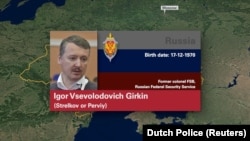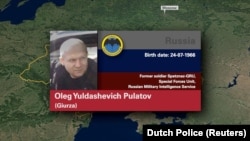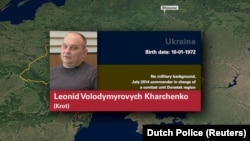On July 19, international investigators announced plans to try three Russians and one Ukrainian for murder in the July 2014 downing of Malaysia Airlines flight MH17, which killed 298 people.
These are the four suspects whose trial – whether they are present or not – is to start in the Netherlands in March 2020: Igor Girkin, Sergei Dubinsky, Oleg Pulatov, and Igor Kharchenko.
Igor Girkin
Girkin, 49, is a Russian national with a pencil mustache, a penchant for war reenactments, and a fondness for online military history forums. He led separatist forces in eastern Ukraine in the early days of the conflict that began in April 2014.
A former Federal Security Service (FSB) officer, he has said he took part in other conflicts that involved Russia prior to the war in Ukraine, as well as Russia’s seizure of Crimea.
Between April and early July 2014, the separatist commander ruled the city of Slovyansk with an iron fist. Girkin – who also calls himself Igor Strelkov -- became notorious after he imposed Stalin-era laws there which led to the execution by firing squad of three local men accused of looting, documents uncovered by this journalist and two others days before MH17 was shot down showed. Girkin later admitted to those executions and an additional one.
On July 5, 2014, Girkin and his forces retreated to the separatist stronghold of Donetsk, the provincial capital, where he would declare himself the “defense minister” of the anti-Kyiv militants in the region. It was 12 days later that he would find himself involved, according to the investigators and other evidence, in the downing of MH17.
In the weeks and days leading up to the shoot-down, investigators said, Girkin appealed to Russian officials in Crimea and Moscow for heavy weapons to stop Ukrainian forces from recapturing territory.
Investigators said Girkin was involved in transporting the Buk missile launcher that downed MH17 from Russia to separatist territory in eastern Ukraine and back across the border.
Reached by Russia’s Interfax news agency after being named a suspect and charged in the downing of MH17, Girkin denied involvement.
Girkin is currently residing in Moscow, where he has made infrequent appearances since leaving eastern Ukraine in August 2014. During that time, he has criticized Putin for not bringing the separatist-held areas into Russia, as Moscow considers that it has done with Crimea. And he seems to have fallen on hard times, even selling a gold medal he was awarded in 2014 for his role in the Crimea annexation.
Sergei Dubinsky
Dubinsky, 56, a Russian national, is originally from Russia’s Rostov region, which borders eastern Ukraine. A former military intelligence officer who served in Afghanistan and Chechnya before becoming the Russia-backed separatists’ intelligence head, Dubinsky is accused of overseeing the transport of the Buk missile launcher used to down MH17.
Dubinsky was known in the conflict by the call sign “Khmury,” Russian for gloomy or grim. In intercepted phone calls shared by investigators, he is heard directing the movements of the Buk.
According to the open-source investigative group Bellingcat, Dubinsky was fond of a Russian online forum called Antikvariat, where he discussed military history and vintage weaponry with other enthusiasts, including Girkin.
Dubinsky was expelled from the area held by the Russia-backed separatists in the Donetsk region after being accused of financial fraud and is thought to have returned to Russia’s Rostov region.
Oleg Pulatov
Pulatov, 52, a Russian national born in the city of Ulyanovsk, is a former lieutenant colonel in the Russian Armed Forces who took part in wars in Afghanistan and Chechnya before leaving the military in 2008.
According to Bellingcat, he graduated from Kyiv’s Frunze military academy in 1990 and received a letter of gratitude for his military service from Putin in 2002.
In eastern Ukraine in 2014, he was subordinate to Dubinsky in the Donetsk-based separatists’ military intelligence. He has been identified as the man behind the call sign “Gyurza” in phone intercepts released by investigators and is accused of escorting and securing the Buk near the launch site close to the town of Snizhne.
Pulatov continued fighting until 2018, when he was arrested and imprisoned in the separatist Luhansk region. According to Bellingcat, Pulatov moved back to Russia after being released. Like Girkin and Dubinsky, Pulatov was an avid user of Antikvariat, according to Bellingcat.
Leonid Kharchenko
The only Ukrainian of the four, Kharchenko, 47, is originally from the eastern industrial city of Kostyantynivka, which had fallen under separatist control early in the conflict but is now in government-controlled territory.
Known by the call sign “Krot” – Russian for mole, the animal -- his photo was featured on billboards with wanted notices for separatists in the Donetsk region in August 2014, Bellingcat said.
Kharchenko had no military experience prior to the breakout of the conflict that April, according to investigators. But in July 2014, he was a high-ranking member of the Donetsk militants’ intelligence unit under Dubinsky’s command.
According to Bellingcat, Kharchenko was involved in securing the Buk missile launcher at the launch site near Snizhne and relayed the order to send it back to Russia after MH17 was shot down.
Kkarchenko is also heard in a phone intercept cursing another separatist after a Buk operator got separated from his unit.
According to an indictment made public by Ukraine’s security service, the SBU, on June 19, Kharchenko was present with the Buk right after it shot down MH17. Reporting to Dubinsky, he said, “They are at the spot and have already downed one sushka," apparently referring to a military plane.





